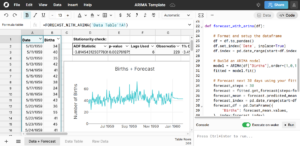
(Kaspars Grinvalds/Shutterstock)
What do you do when your data set exceeds Microsoft Excel’s limit of 1 million rows? You could shell out thousands for analytics tools or even a big data warehouse, but you’ll probably still find yourself exporting CSVs to Excel. Another alternative has emerged with Row Zero, a new cloud-hosted spreadsheet developed by former AWS engineers that scales up to a billion rows.
Despite its age and its limitations, Microsoft Excel remains one of the most–if not the most–popular analytics tools in history. The ability to view and manipulate one’s data in a single intuitive interface remains the humble spreadsheet’s secret weapon.
But the power of Excel and Google Sheets are tempered by several limitations, not the least of which is the 1 million row limit. In reality, many spreadsheets become practically unusable as they near the half-million-row mark, thanks to the limited computing resources on a desktop or laptop.
Excel’s legacy codebase turns 40 years old this year, and even Google Sheets’ architecture, which was developed in 2006, before the cloud era took off, utilizes the client’s compute resources to manipulate data and run formulas. And while Google Sheets centralizes spreadsheets, the constant extracting of CSVs and sharing of spreadsheets in Excel poses serious security and privacy issues.
Row Zero attempts to solve these issues with its cloud-hosted spreadsheet service. The offering is built on a modern stack that allows users to browse and crunch much larger sets of data–well beyond the 1 million-limits of Excel and Sheets–from the comfort and familiarity of a spreadsheet.
“I say there’s no better interface for touching and interacting with data than the spreadsheet,” said Breck Fresen, the CEO and co-founder of Row Zero. “It’s the ultimate interface for data. And Excel has limitations, but you shouldn’t throw out the great interface. You should address those limitations like performance and security and lack of a modern programming environment rather than just punting on the spreadsheet interface.”
Excel Data Dance
The backstory of Row Zero will sound familiar to any analyst who has ever been frustrated with the need to constantly extract, move, load, and re-load CSVs, dubbed the Excel Data Dance.
As a principal engineer working on the S3 object store at AWS, one of Fresen’s jobs was working on the data placement algorithm that decided not only which disk to move data to, but which sector of the spinning hard drive. That meant he needed data about each and every S3 drive.
“The key data set is the list of all hard drives in S3 and how full are they and how busy are they” Fresen says. “How much time are they doing I/O versus being idle? Hot spotting is a huge problem. You get too many requests going to one disk–that’s really what you’re trying to avoid.”
However, with more than 10 million drives in the AWS fleet, just getting the data in a single place to understand it was a challenge. Fresen found himself doing the Excel Data Dance, which in his case involved writing some SQL to export data to Excel. Things were fine when the data was in Excel, but the disconnected nature of the analysis was a pain.
“If you want to refresh it, you have go do the whole thing again,” Fresen said. “If you want to email it to someone, they have to be able to do SQL too. And what I really wanted was just a Google Sheet-type experience, where I could send a non-technical business partner in finance or supply chain a link–here’s the workbook and have that thing be live updating, and just pull all the data directly into the spreadsheet.”
Like many enterprises, AWS has an abundance of BI and analytics tools. They also develop their own product, Amazon Quicksight, although Tableau is quite abundant. While the BI and analytic tools have their place, Nick End, a mechanical engineer, also longed for the power and simplicity of Excel.
“Both Breck and I had to do a bunch of data analysis, and it always seemed like it would have been easier if we could have just done it in a spreadsheet,” he said. “And so we essentially said, if you were to start building Excel today, how would you build it? And you would run it in the cloud, it would connect to all your different data repositories. You could run on bigger hardware, open giant data sets. And then the other big benefit of that is from a security standpoint, we can trap sensitive data in the cloud. So you don’t have CSVs floating around on people’s laptops or sensitive Excel files floating around on people’s laptops.”
A New Spreadsheet Is Born
About four years ago, Fresen and End decided to do something about the Excel Data Dance. They decided to develop a cloud-hosted spreadsheet that overcame the downsides of Excel while retaining the parts that users love.
They used the latest technologies and techniques to build Row Zero. They looked to Michael Stonebreaker’s concepts around columnar storage of data for analytics. They used Rust to create a columnar engine and paired it with a key-value store for the data. They also use React and Canvas JavaScript engines to power the user interface, and a good bit of TypeScript as well.
“Essentially under the hood, Row Zero is a columnar key-value store,” Fresen said. “We have mapped all of the spreadsheet APIs like cut, paste, undo, redo, update, cell formatting, all of that onto a columnar engine. That’s kind of the software magic of it. And then running it in the cloud is the hard bit.”
The Row Zero compute engine scales vertically, which allows it to utilize AWS’s largest EC2 instances, or up to 32TB of RAM, Fresen said.
“Typically customers are pulling on the order of 100 million to 1 billion rows out of [Snowflake and Databricks] into Row Zero, where they can then have the full flexibility of the spreadsheet,” he said. “We’re also much faster than those data warehouses as well. Everything in Row Zero is instant because it can all fit on a single instance.”
Row Zero stores data on AWS S3 until a spreadsheet is opened, at which point the data is moved to RAM and NVMe drives. Thanks to the buildout of data centers around the world, most customers will experience almost a maximum of about 30 milliseconds of latency when using Row Zero from their Web browsers. The use of Apache Arrow also helps make it fast.
Row Zero comes with about 200 pre-built formulas for the most common Excel routines, and also features a graphing engine and an embedded Jupyter-based data science notebook where users can execute Python scripts.
Row Zero is only available on AWS for now. The service requires an Internet connection to function, which is one of the limitations compared to Excel. However, in the age of Starlink, that shouldn’t be a major issue.
Customer Traction
Since launching about 15 months ago, Row Zero has started signing up users of all sizes. It has hundreds of users at this point, and demand is growing strong. The Row Zero message is resonating with customers who want to analyze data sets that are too big to fit into Excel but for whom a distributed data warehouse like Snowflake or Databricks is overkill.
“I think big data is in the eye of the beholder,” Fresen said. “For many of our customers, prior to Row Zero, big data meant just didn’t fit in Excel. And we’re expanding what you can do to make that more accessible to people with the spreadsheet interface.”
There’s a certain amount of prestige that comes with pushing the limits of big data technology. Today’s distributed data warehouses are enormously powerful, and give users the capability to run queries on a petabyte of data, and get the results back very quickly. That appeals to certain folks, including data scientists and engineers working on big, hairy problems. But that doesn’t take away from Excel’s inherent qualities.

Spreadsheets remain widely used despite more sophisticated BI and analytics tools being available (Kaspars Grinvalds/Shutterstock)
“I’m a technical user. I’m an engineer, but I still love the spreadsheet interface,” Fresen said. “I think there’s a class of person who says spreadsheets are for non-technical people. They’re not sophisticated, right? ‘I’m a data scientist. I don’t need that.’ But I reject that.”
Fresen calls Excel a miracle of software. Copy and paste is “magical,” he said, and the capability to package everything up into an XLS file and then share it with another person delivers the “write once, run anywhere” promise that Java ultimately failed to deliver. Excel is so great that even Microsoft has been forced to keep it pretty much as is for nearly two decades. As technology has progressed over that time, the gap between what Excel is and what it could be if given a modern foundation has grown.
With Row Zero, Fresen and his colleague seek to honor the legacy of Excel while bringing it into the technological present.
“We’re careful to not disparage Excel too much because it’s an amazing tool,” Fresen said. “But Microsoft has let it languish basically for 18 years and hasn’t made it better with all of the stuff in computing that has happened in the last 18 years. So we see a big opportunity to take the good parts of Excel, okay, try to emulate that and then and then build on that.”
Related Items:
Why This Spreadsheet Interface for Cloud DWs Is Turning Heads
Survey: Excel Remains Go-To Data Prep Tool
Anaconda’s New Tool Lets Users Run Python Code Inside Excel


